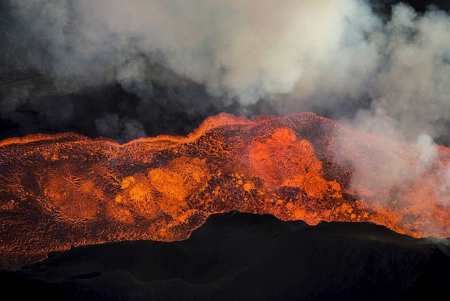The subsidence of the Bárðarbunga caldera is still significant
Scientists from the Icelandic Met Office and the Institute of Earth Sciences University of Iceland along with representatives from the Icelandic Civil Protection, Directorate of Health and The Environment Agency of Iceland met this morning at the Crisis Coordination Centre. The results of the meeting are as follows. The volcanic eruption in Holuhraun continues. Small if any changes of the intensity of the eruption have been detected over the last few weeks.
Seismic activity in Bárdarbunga continues to be strong. Five earthquakes between M4.0-4.6 were detected since the last meeting of the Advisory Board on Friday. The strongest one was measured at M4.6 yesterday at 21:35. About 10 earthquakes between the magnitudes M3.0-3.9 were detected over the period. In total around 130 earthquakes were detected around the caldera since last Friday, or between 20 and 30 per day. No earthquake over M5,0 has been detected in Bárdarbunga since January 8th. Around 10 earthquakes per day were detected in the dyke during the same period. All of them were under M2.0. GPS measurements near the northern Vatnajökull glacier show continuing slow deflation towards Bárdarbunga. On Saturday around 2300 µg/m³ of SO2 was measured in Höfn in Hornafjördur.
A new risk analysis for the area around the eruption site is being conducted. The new risk map for the area will be issued next week. Today (Tuesday) gas pollution will affect the area around Holuhraun, but mainly northeast and east of it in the afternoon. Tomorrow (Wednesday) gas pollution might be felt to the east of the eruption.
The volcanic eruption has now been going on for five months, the lava flow is still great in Holuhraun and the rate of the subsidence of the Bárdarbunga caldera is still significant.
Three scenarios are considered most likely: The eruption in Holuhraun continues until the subsidence of the Bárdarbunga caldera stops. The eruption can still go on for many months. The volcanic fissure may lengthen southwards under Dyngjujökull, resulting in a jokulhlaup and an ash-producing eruption. It is also possible that eruptive fissures could develop in another location under the glacier. If such an eruption would be prolonged it could eventually produce a lava flow. Volcanic eruption in the Bárdarbunga caldera. Such an eruption would melt large quantities of ice, leading to a major jokulhlaup, accompanied by ash fall. Other scenarios cannot be excluded.From the Icelandic Met Office: The Aviation Colour Code for Bardarbunga remains at orange. The next meeting will be held on Friday 6 of February 2015.






/frimg/1/48/1/1480176.jpg)

